The Code Liberation Foundation offers development workshops that are free of charge to encourage more women to explore and create their own video games. Not too long ago, they celebrated their two-year anniversary on exactly the same day as the official International Women’s Day on March 8. Accompanying this year’s anniversary is Code Liberation’s first women’s history month game jam sponsored by Microsoft and MailChimp. For the whole weekend on March 28th and 29th, women programmers, artists, musicians, and individuals curious or passionate about game development have stepped up to the challenge to make a game in less than 48 hours at New York City’s Microsoft building.
At around 8:00 a.m. on Saturday morning, I patiently waited for the doors to open. It was somewhat bizarre to walk around midtown at that time because the streets were surprisingly tame, which left me with a temporary feeling of relief. Though spring started two weeks ago, the weather was still clinging onto the remains of winter. Within a few minutes of waiting, I saw Stacey Mulcahy, the lead organizer for the weekend’s game jam, and shortly after I met up with Maria Naggaga and Asia Hoe, who were also organizing the event.
The brisk winds did not stop the participants from pouring into the game jam. When most had settled in, a short presentation was delivered, briefly going over the basic code and conduct, as well as internship opportunities from Microsoft offered by recruiter Kelly Eng, as well as examples of game resources the participants may use to build their games. Revealed at the end of the slide was what everyone was waiting for, the theme: harmony. The theme was fitting because it complements the purpose of this game jam: to bring more women together to make games.
From Saturday morning until Sunday afternoon, the participants worked through their games until they had a functioning prototype. Understandably, expending your energy on a game for hours straight can be exhausting, especially if you are running on an empty stomach. We did not want anyone dropping on their knees and shaking their fists in the air as they yell, “I’ll never go hungry again!” Doughnuts and pizza were generously provided to prevent that from happening.
At around 4:00 p.m. on Sunday, Catt Small, one of the gam jam organizers, declared that it was time to stop development, and after a few seconds of exasperated sighs, the whole room clapped and congratulated each other for a job well done—the gruelling part of the game jam was over, and the only thing left to do was to demo their projects. Truly, I am impressed that there were ten solid games that came out of the jam, and I was fortunate enough to see a solid play through of nine games.
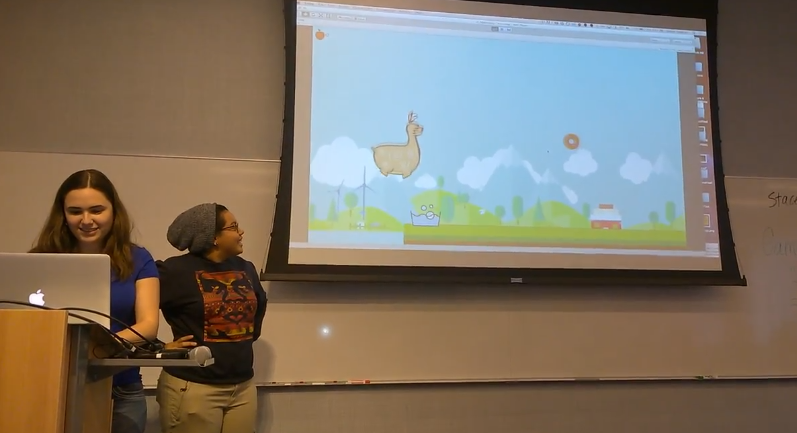
Pancho’s Harmony by Kimberly Torres, Jaclyn Jimenez, and Desiree Frieson
Game Engine: Unity 2D
You are Pancho and your goal is to find food and water “to make your [other alpaca] friends happy” in order to restore harmony. What I liked about this game is their color palette choice, as well as the animation on the alpacas—their wiggling tails are so meltingly adorable.
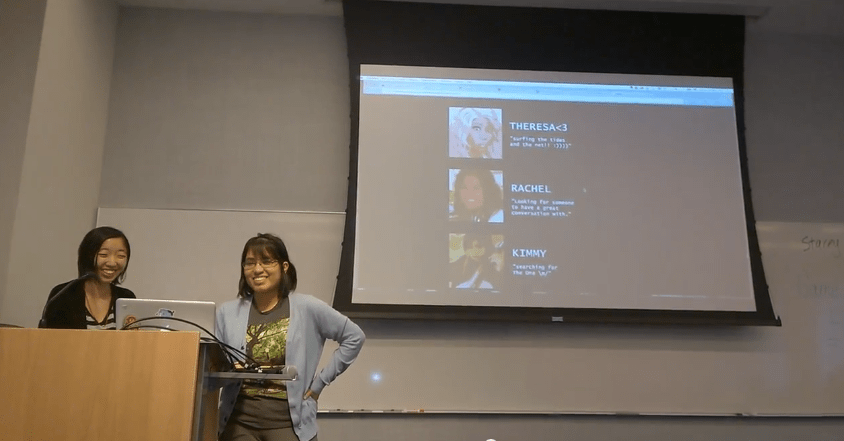
Findr by Sandra Honigman, Alicia Feng, and Kathy Burkett
Game Engine: Twine
The story revolves around you, an individual who has recently broken up with your partner, and you’re ready to “hook up again” for a double date that your friend has been egging you to do. The title of the game Findr is based on the phone application Tinder. I think it is clever that they used Twine as a platform to make this game because in a similar way, and in the literal sense, Tinder too is a choose-your-own-adventure (minus the retries). In the game, you type in your name, and afterwards the game allows you to pick your preference and it generates a list of profile pictures with truncated biographies, just like any online dating service. From what I have gathered, I think the “harmony” comes into play because the character in the game is striving to harmonize with other individuals.
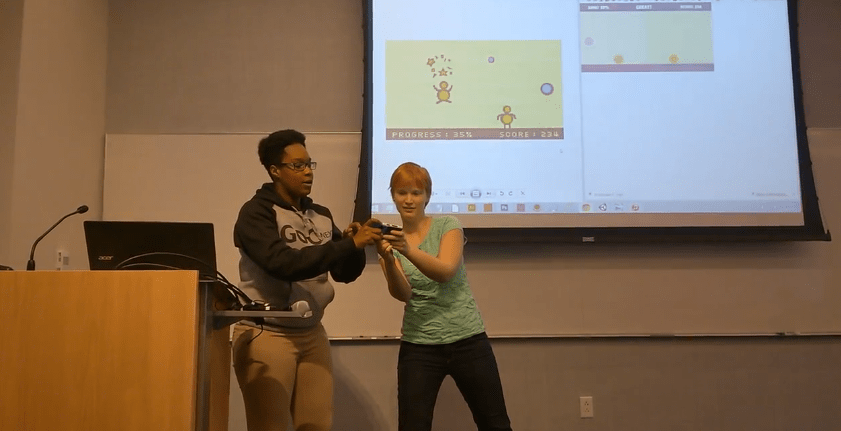
Jump Note by Rachel Bazelais and Olga Andreyeva
Game Engine: Unity 2D
Jump Note is a two-player rhythm game where both players work together to collect the notes, as they stay synced to the music that’s playing. Reaching “harmony” will give additional bonus points if you and your partner both hit the right notes at the same time. This is a game I could easily see myself casually playing with friends in a café whilst sipping our bubble tea.
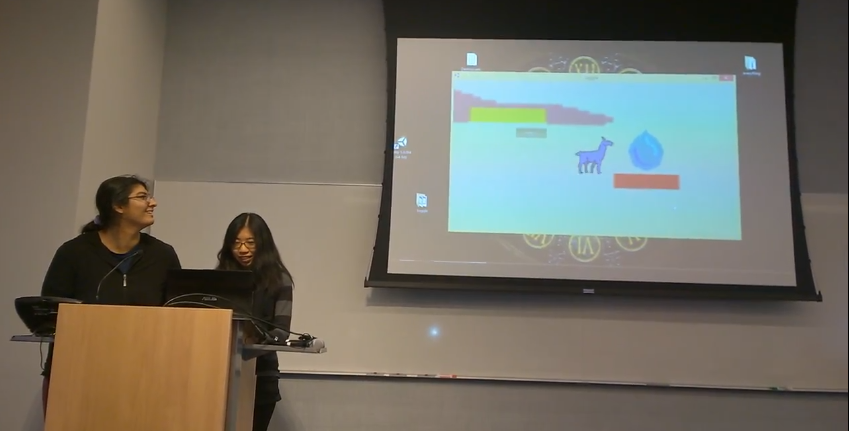
Resurrect Earth by Helen See, Rosheen Chaudhry, Jasmine Feng, and Risham Chokshi
Game Engine: Unity 2D
Equipped with furriness, llamas have been assigned the task of saving the earth’s environment and restoring harmony. As a blue llama, you have to find all the water droplets in the first stage. The stage has rectangular platforms that the player must jump on to reach the water droplets, and once you have gathered these tokens, the stage ends. The team mentioned that they will be adding more puzzle mechanics on top of the current build, and I am looking forward to seeing where they take this game.
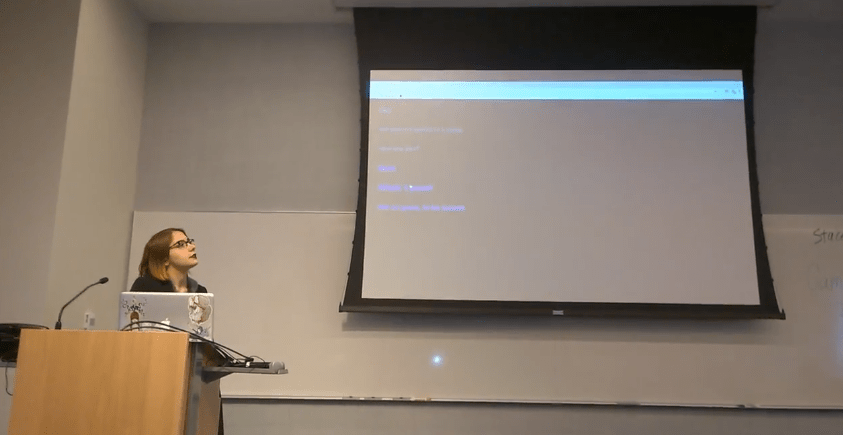
intune by Yves DeSousa
Game Engine: Twine
Yves has produced a twine-based audio game, where the player starts a conversation with an anon. For every option you click, there is a specific sound that is attuned to that choice. Your emotions are directly tied to the texture, intensity, and tone of the audio being played. If your character starts feeling anxious, a sound will resonate, and if your character is calm, then a different audio would play to match that feeling. By listening to the varying levels of sounds, the player can gauge out how much harmony is achieved in the chat.
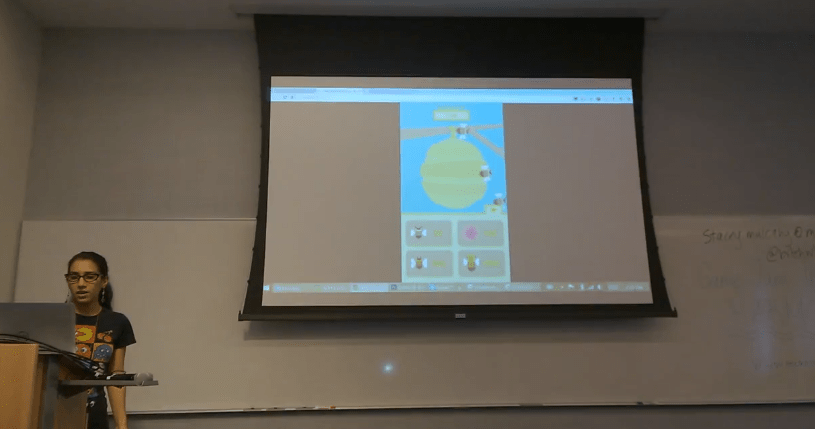
Harmony Hive by Ashley Alicea and Nupus Katakwas
Game Engine: Construct 2
Harmony Hive is an incremental game, and their take on the theme harmony is one of my favorites because I’m an ecology nerd, and I dig this game’s take on the systemic relationships between organisms and their abiotic environment: “The object of the game is to create a harmonious hive by building up from the basic bee to getting a queen bee.” The player clicks on the hive until there are enough bees to populate the community, and once enough honey is collected, the player can then acquire a queen bee, thus creating a “harmonious hive.”
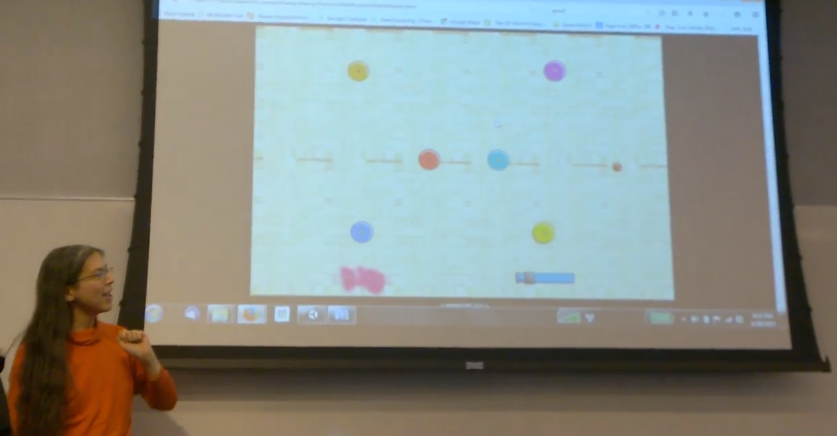
Magnet Music by Benevolence Ng, Liz Blessing, Arielle Martinez, and Mubiyna Casey
Game Engine: Unity 2D
Magnet Music is a cooperative 2D puzzle pinball game that uses magnet physics to move the pinball. Both players are assigned their own magnets, and once the ball hits the magnet, the ball starts moving around the magnet like the Earth orbiting the Sun. The ball will continue to loop around the magnet unless the player presses a key to shoot the ball off to a new trajectory. The goal is to hit the tubes that would then generate a layer of music per tube. Once all tubes have been knocked down, the whole song comes together in a striking harmony.
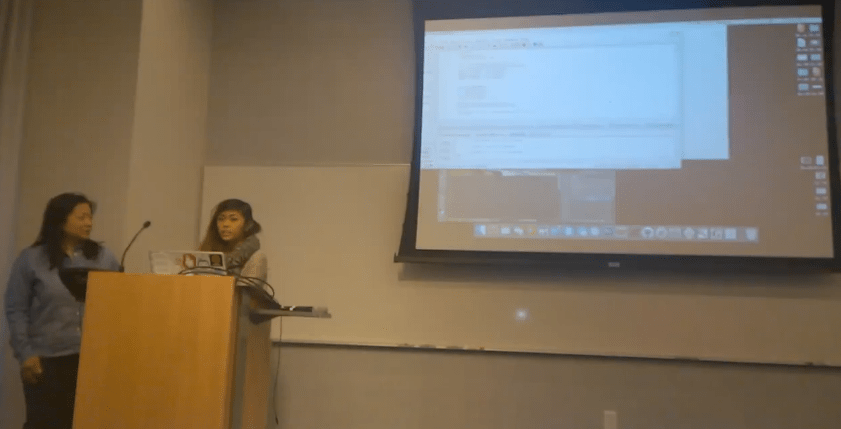
Star Island by Jacqueline Linang, Maria Campbell, and Jennifer Lau
Game Engine: IDE, Web, and Java
The game is a direct result of Ellen Pao’s unfortunate experience with subtle sexism at her workplace. Star Island is an incremental game where you play as Bryce, a rising entrepreneur in the business industry. You are placed in varying scenarios within the tech sphere where you have to make a choice, and depending on which choice you pick, certain attributes would either increase or decrease. The end goal is to land a mentor.
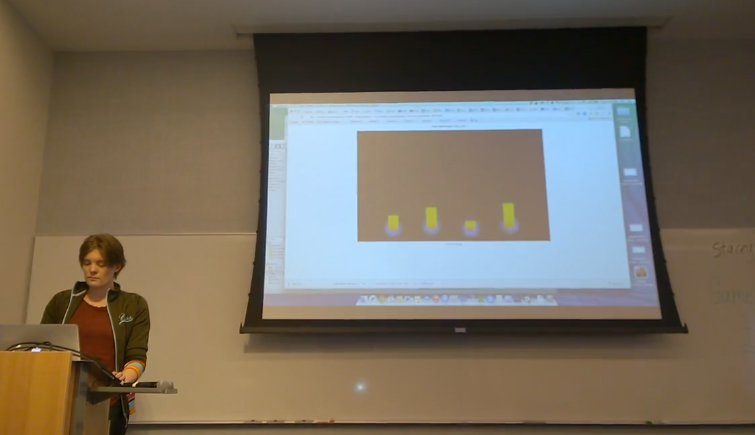
Symphonalia by Emma Larkins, Alyssa Menes, and Brigitte Jellinek
Game Engine: Unity 3D
Symphonalia is an audio adventure game. You control the player in a 3D environment that is not visible to you. The only graphic available is an audio visualizer that picks up on the sound cues you encounter as you move around the game plane. The tone of the music changes as you inch closer to your end destination. I really appreciate the experimental design on Symphonalia because it pushes the boundaries of our senses. We rely so much on our eyes to play games, but this is a game where you can play with your eyes closed.
When the game jam wrapped up the last demo, the room applauded each other once more—it felt good, and I believe everyone in that space shared the same sentiment as I did. Stacey asked in the beginning of the game jam to “raise your hand if you want to be in a team” and almost everyone in the room did so. No one treated anyone as a stranger, even though most of us did not know each other. There was a sense of camaraderie that we all shared because we were all there to learn and create. Out of all the game events I have attended, I think this one takes the cake for making me feel cozy and calm. And at the end, Maria also asked “to raise your hand if you have made a friend” and all hands went up.
Kaira is perpetually hungry and when she is not thinking about food, she is either busy developing games or scrutinizing ecological patterns. You can tweet to her about hedgehogs and cupcakes @zovfreullia.
Are you following The Mary Sue on Twitter, Facebook, Tumblr, Pinterest, & Google +?



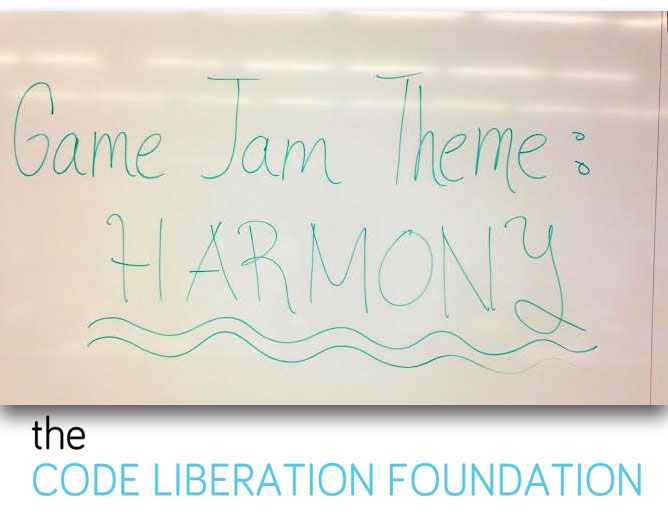





Published: Apr 3, 2015 10:30 am